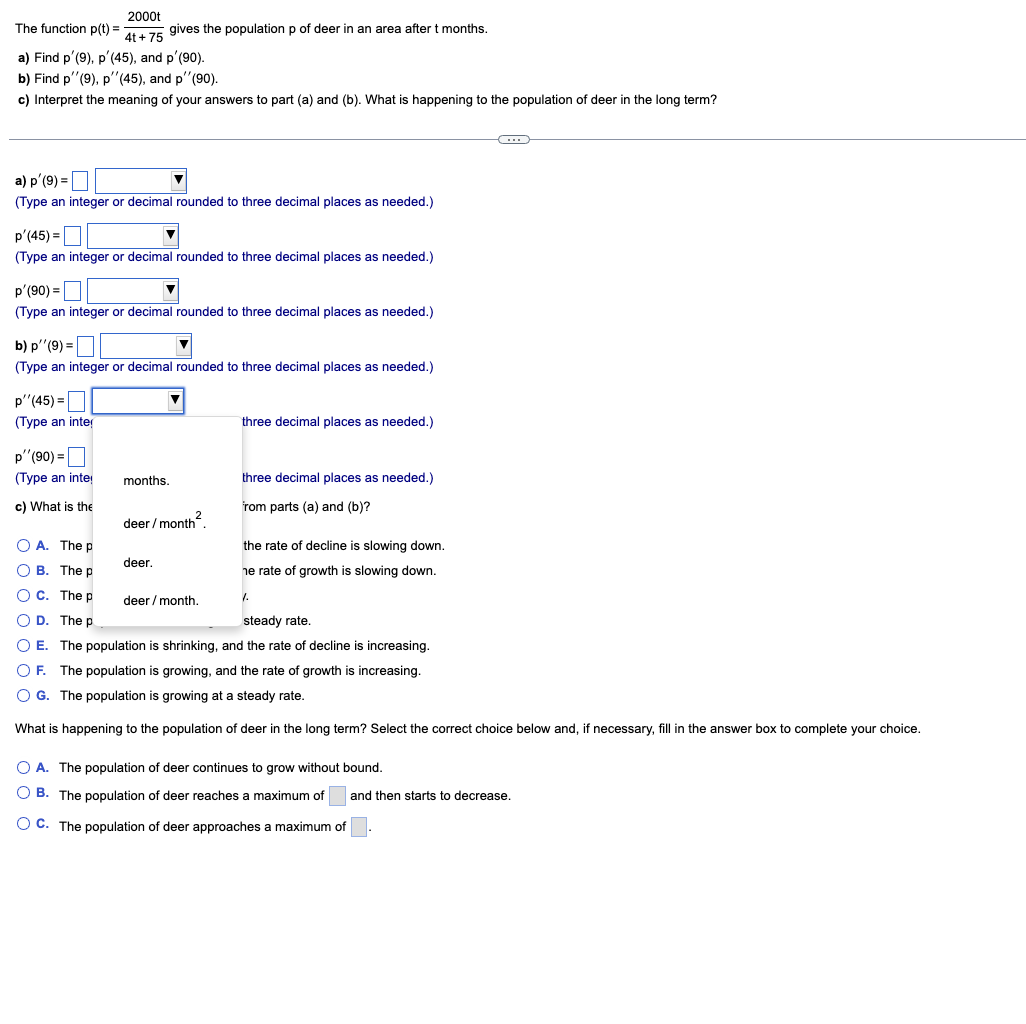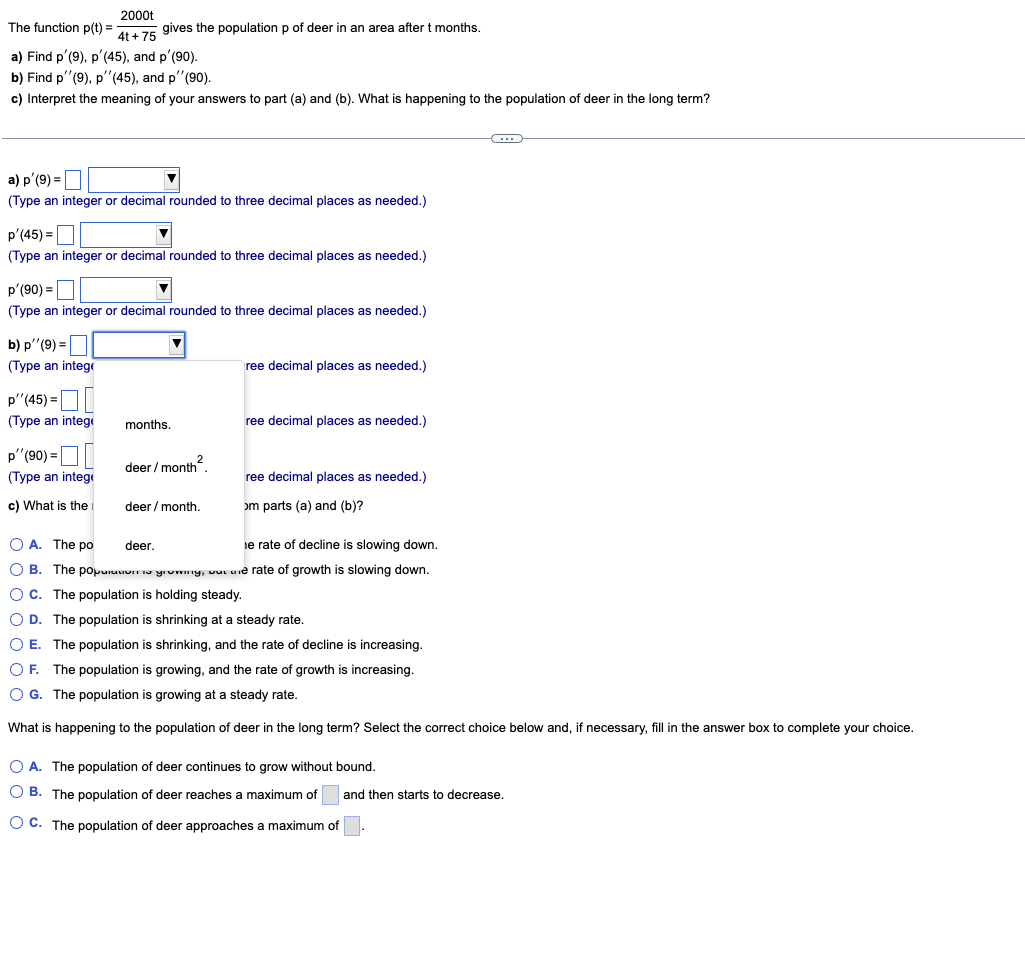Algebra & Trigonometry with Analytic Geometry
13th Edition
ISBN:9781133382119
Author:Swokowski
Publisher:Swokowski
Chapter7: Analytic Trigonometry
Section7.3: The Addition And Subtraction Formulas
Problem 76E
Related questions
Question
35

Transcribed Image Text:2000t
The
function p(t) =
gives the population p of deer in an area after t months.
4t+75
a) Find p'(9), p'(45), and p'(90).
b) Find p''(9), p''(45), and p''(90).
c) Interpret the meaning of your answers to part (a) and (b). What is happening to the population of deer in the long term?
a) p'(9) =
(Type an integer or decimal rounded to three decimal places as needed.)
p'(45)=
(Type an integer or decimal rounded to three decimal places as needed.)
p'(90) =
(Type an integer or decimal rounded to three decimal places as needed.)
b) p''(9) =
(Type an integer or decimal rounded to three decimal places as needed.)
p''(45)=
(Type an inte
three decimal places as needed.)
p'' (90)=
(Type an inte
months.
three decimal places as needed.)
c) What is the
from parts (a) and (b)?
deer/month².
OA. The pl
the rate of decline is slowing down.
deer.
he rate of growth is slowing down.
OB. The p
OC. The p
deer/month.
1.
steady rate.
O D. The p
O E. The population is shrinking, and the rate of decline is increasing.
O F. The population is growing, and the rate of growth is increasing.
OG. The population is growing at a steady rate.
What is happening to the population of deer in the long term? Select the correct choice below and, if necessary, fill in the answer box to complete your choice.
O A. The population of deer continues to grow without bound.
and then starts to decrease.
OB. The population of deer reaches a maximum of
OC. The population of deer approaches a maximum of

Transcribed Image Text:2000t
The
function p(t) =
gives the population p of deer in an area after t months.
4t+75
a) Find p'(9), p'(45), and p'(90).
b) Find p''(9), p''(45), and p''(90).
c) Interpret the meaning of your answers to part (a) and (b). What is happening to the population of deer in the long term?
(...)
a) p'(9) =
(Type an integer or decimal rounded to three decimal places as needed.)
p'(45)=
(Type an integer or decimal rounded to three decimal places as needed.)
p'(90) =
(Type an integer or decimal rounded to three decimal places as needed.)
b) p''(9) =
(Type an integ
ree decimal places as needed.)
p'(45)=
(Type an integ
months.
ree decimal places as needed.)
p'' (90) =
(Type an integ
deer/month²
ree decimal places as needed.)
c) What is the
deer/month.
om parts (a) and (b)?
O A. The po
deer.
he rate of decline is slowing down.
OB. The popurua gromny, but e rate of growth is slowing down.
OC. The population is holding steady.
O D. The population is shrinking at a steady rate.
O E. The population is shrinking, and the rate of decline is increasing.
O F. The population is growing, and the rate of growth is increasing.
O G. The population is growing at a steady rate.
What is happening to the population of deer in the long term? Select the correct choice below and, if necessary, fill in the answer box to complete your choice.
O A. The population of deer continues to grow without bound.
OB. The population of deer reaches a maximum of and then starts to decrease.
OC. The population of deer approaches a maximum of
Expert Solution
This question has been solved!
Explore an expertly crafted, step-by-step solution for a thorough understanding of key concepts.
Step by step
Solved in 3 steps with 1 images

Recommended textbooks for you

Algebra & Trigonometry with Analytic Geometry
Algebra
ISBN:
9781133382119
Author:
Swokowski
Publisher:
Cengage

Algebra & Trigonometry with Analytic Geometry
Algebra
ISBN:
9781133382119
Author:
Swokowski
Publisher:
Cengage